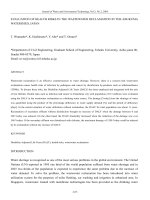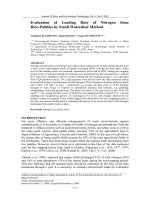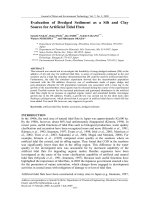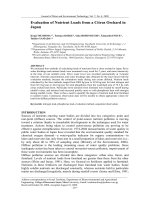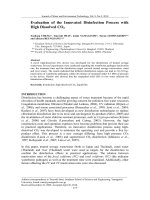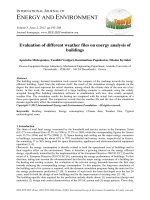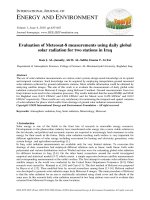Evaluation of cDNA libraries from different developmental stages of schistosoma mansoni for production of expressed sequence tags (ESTs)
Bạn đang xem bản rút gọn của tài liệu. Xem và tải ngay bản đầy đủ của tài liệu tại đây (1.05 MB, 10 trang )
DNA RESEARCH 4, 231-240 (1997)
Evaluation of cDNA Libraries from Different Developmental
Stages of Schistosoma mansoni for Production of Expressed
Sequence Tags (ESTs)
Gloria R. FRANCO, 1 Elida M. L. RABELO, 2 Vasco AZEVEDO, 3 Heloisa B. PENA, 1 J. Miguel ORTEGA, 1
Tiilio M. SANTOS,1 Wendell S. F. MEIRA, 1 Neuza A. RODRIGUES,1 Carlos M. M. DIAS, 2 Richard HARROP, 5
Alan WILSON, 5 Mohamed SABER,6 Hannan ABDEL-HAMID, 6 Michelyne S. C. FARIA, 7
Maria Elizabeth B. MARGUTTI, 4 Jugara C. PARRA, 7 and Sergio D. J. PENA 1 '*
(Received 7 April 1997)
Abstract
A comparative study of the gene expression profile in different developmental stages of Schistosoma
mansoni has been initiated based on the expressed sequence tag (EST) approach. A total of 1401 ESTs
were generated from seven different cDNA libraries constructed from four distinct stages of the parasite life
cycle. The libraries were first evaluated for their quality for a large-scale cDNA sequencing program. Most
of them were shown to have less than 20% useless clones and more than 50% new genes. The redundancy
of each library was also analyzed, showing that one adult worm cDNA library was composed of a small
number of highly frequent genes. When comparing ESTs from distinct libraries, we could detect that most
genes were present only in a single library, but others were expressed in more than one developmental stage
and may represent housekeeping genes in the parasite. When considering only once the genes present in
more than one library, a total of 466 unique genes were obtained, corresponding to 427 new S. mansoni
genes. From the total of unique genes, 20.2% were identified based on homology with genes from other
organisms, 8.3% matched S. mansoni characterized genes and 71.5% represent unknown genes.
Key words: Key Words: Schistosoma mansoni; developmental stages; cDNA sequencing analysis; expressed sequence tags
Despite intense efforts dedicated to eradicating schistosomiasis through sanitary measures, suppression of the
Schistosoma mansoni (Sm) is a digenetic trematode intermediate host and drug treatment, the prevalence of
worm responsible for schistosomiasis, a parasitic disease the disease has not decreased. No vaccine is yet availthat is estimated to affect at least 300 million people in able and control of the disease is primarily by chemothertropical and subtropical areas of the world (WHO, 1985). apy. However, reinfection of patients is common and we
need new approaches to treatment and prevention, since
Communicated by Kenichi Matsubara
* To whom correspondence should be addressed. Departamento 5. mansoni is becoming increasingly resistant to drug
de Bioquimica e Imunologia, ICB/UFMG. Av. Antonio Carlos, therapy. It is hoped that detailed information about the
6627, Belo Horizonte, MG 31270-010, Brazil. Tel. +5531-227genome of 5. mansoni might uncover key gene products
3496, Fax. +5531-227-3792, E-mail:
f EST sequences were deposited in dbEST and Gen- that may constitute new targets for drug and vaccine deBank with the following accession numbers: Adult 1 li- velopment.
brary (T14340^T14651; T18616->T18626; T24126->T24150;
Accordingly, in 1992 we started a systematic gene disW06712-»W06824); Adult 2 library (AA185747^AA185837),
covery
program study in S. mansoni using the stratAdult 3 library (AA218448->AA218524); Adult 4 library (AA125663^AA169943), Egg library (AA140558^ egy of partial sequencing of cDNA ends to generate exAA140638);Cercariae library (AA143808^AA143896); Lung pressed sequence tags (EST).1 Initially, we utilized an
stage schistosomula library (AA125668—>AA125734).
adult worm cDNA library, from which 607 ESTs were
1.
Introduction
Downloaded from by guest on May 16, 2016
Departamento de Bioquimica e Imunologia,1 Departamento de Parasitologia,2 Departamento de Biologia
Geral 3 and Departamento de Microbiologia, Universidade Federal de Minas Gerais, Belo Horizonte,
Brazil 31270-010,4 Department of Biology, University of York, York, Y015DD, UK,5 Theodore Bilharz
Research Institute, Cairo, 12411, Egypt6 and Centro de Pesquisas Rene Rachou, Belo Horizonte,
Brazil 30190-0027
232
ESTs from S. mansoni cDNA Libraries
2.
Methodology
2.1. Construction of cDNA libraries and sequencing
The following seven cDNA libraries were used in this
study: four libraries (Adult 1-4) from adult worms and
one library each from ova (Egg), cercariae and lung stage
schistosomula (Lung stage). The construction of the
Adult 1 cDNA library, plasmidial DNA preparation and
sequencing of clones from this library have been previously described.2 The other six libraries were constructed
in AZapII (Stratagene), according to the manufacturer's
instructions. Total RNA was isolated from distinct
5. mansoni developmental stages by the guanidinium
thiocyanate-phenol-chloroform method4 and poly(A)+
RNA was obtained by chromatography on an oligo
(dT) column.5 Double-stranded cDNA was cloned into
EcoRI/Xhol restriction sites of AZapII. pBluescript SK+
phagemids were obtained by "en masse" in vivo excision of AZap clones,6 by co-infecting Escherichia coli
XL-1 Blue cells with the ExAssist helper phage (Stratagene). The excised phagemids were used to infect
E. coli SOLR™ cells (Stratagene) for production of
double-stranded DNA (dsDNA) templates. Transformants were plated onto LB agar containing ampicillin, Xgal and isopropyl-/3-D(-)-thiogalactopyranoside (IPTG).
White colonies were selected and grown for 16 hr in
3 ml of Luria broth (LB) supplemented with ampicillin.
Aliquots of the cultures (200 /xl) were mixed with the
same volume of 30% glycerol in LB and frozen at — 70° C
in 96-well plates. The rest of the cultures were used for
plasmidial DNA preparation using the Wizard Plus Mini
Prep DNA Purification System (Promega). dsDNA was
sequenced by dideoxy chain-termination sequencing7 using the Thermo-Sequenase Cycle Sequencing kit (Amersham) and M13 Reverse or M13-40 fluorescent-labeled
primers (Pharmacia). Single-pass runs of the sequencing
reactions were performed on an A.L.F. automated DNA
sequencer (Pharmacia).
2.2. Data analysis
Sequences were manually edited to eliminate vector regions, poly(A) tails and lower quality data at the end
of the sequence. ESTs containing less than 150 bp and
more than 4% ambiguity were rejected. ESTs were compared to DNA and protein sequences deposited in nonredundant databases using the Basic Local Alignment
Search Tool (BLAST) programs8 at the National Center
for Biotechnology Information (NCBI). Alignments scoring more than 200 for BLASTN and 100 for BLASTX
were selected and after meticulous visual inspection on
the biological significance of the alignment, ESTs were
named as putative identification for the gene. ESTs with
no significant database matches or showing only partial
homology with database sequences were grouped as nonidentified genes.
2.3. Clustering analysis:
Sequences sharing local similarities were clustered with
the ICATOOLS set of programs9 (freely available at
ftp.ebi.ac.uk). Initially, each library was independently
analyzed. The module ICAass was used to create an index of clustered sequences (threshold and ktup set to 25
and 8, respectively). One singular sequence was added to
the cluster with ICAass and used to run the module ICAtool, under the same threshold and ktup settings. This
was followed by the run of ICAtool with all sequences in
the library. ICAprint was used to generate the output
file, that was manually inspected since some clones had
been sequenced in both orientations and/or led to the
same identification when submitted to homology search.
A second round of analysis was conducted with all libraries concomitantly in order to join the clusters that
had been previously formed, but for this purpose only
ICAass followed by ICAtool with a singular sequence was
executed.
Downloaded from by guest on May 16, 2016
obtained, corresponding to 169 different genes, 15 previously known in 5. mansoni and 154 new genes.2 This
increased considerably the number of genes identified in
the parasite. However, we felt that studying only adult
worms was insufficient. S. mansoni has a complex life cycle with several morphologically very diverse stages (ova,
miracidia, cercariae, schistosomula and adult worms),
during which different sets of genes are expressed. Obviously, if one considers the acquisition of information
about the worm gene expression in the perspective of
designing new drugs and vaccines, the young stages can
not be overlooked. Actually, the schistosomula stage is
increasingly recognized as one of the main targets for the
host immune system.3
With this in mind, we planned to extend our EST program to the other life stages of S. mansoni. For that,
stage-specific cDNA libraries were needed, some of which,
unfortunately, are very difficult to construct because of
difficulties in obtaining the necessary amounts of pure
mRNA. Thus, before embarking on large-scale studies,
we decided to evaluate the libraries that were already in
existence, comparing them with our original adult worm
library. We here report our results with seven different
cDNA libraries constructed from four distinct stages of
the parasite life cycle, from which a total of 1401 ESTs
were generated, totaling 466 different genes, 427 of which
are newly describe in S. mansoni. From the total of
identified genes, we can start to outline a pattern of gene
expression, with some genes expressed in a stage-specific
manner and others, housekeeping ones, in all developmental stages.
[Vol. 4,
No. 3]
G. R. Franco et al.
233
Table 1. Information about the sequencing of different S. mansoni cDNA libraries.
S. mansoni cDNA libraries
Number
Number
Number
Number
of
of
of
of
ESTs
sequenced clones
usable ESTsa>
usable clones'1'
Egg
106
107
80
80
Cercariae
Lung staj;e
Adult 1
Adult 2
Adult 3
Adult4
110
107
98
98
107
107
67
67
812
617
657
504
94
94
91
91
101
101
78
78
71
71
52
52
Total
1401
1204
1123
970
a
' ESTs/clones analyzed by ICATOOLS. These numbers correspond to the total number of ESTs/clones after removing sequences of
vector, mitochondrial DNA, rRNA and contaminating sequences from other organisms.
Adams et al. 10 proposed criteria to evaluate the quality of the libraries used in large-scale EST analysis. They
3.1. Quality control of the cDNA libraries
state that the sequencing of 100-200 clones from a liSince the start of S. mansoni genome project, one of brary is sufficient to assess the quality of this library
our main focuses has been the large-scale sequencing of and to detect problems that might have occurred durcDNA to produce ESTs, in an attempt to identify new ing library construction. A useful library should congenes of this organism. Initially, we used an adult worm tain no more than 20% useless sequences, at least 50%
cDNA library, from which we generated 607 ESTs cor- new genes and a broad variety of transcripts. We used
responding to 154 new S. mansoni genes.2 The good their criteria to evaluate the seven cDNA libraries used
quality of this library was attested by the diversity of in this study (Fig. 1). The first five parameters are a
genes that were isolated, even after the discovery of a measure of the proportion of useless clones. In general,
significant degree of redundancy (65% of the sequenced the libraries were of good quality with respect to these
clones corresponded to 49 redundant genes). 2 The suc- parameters, except for the Lung stage, Egg and Adult 3
cess of this approach prompted us to extend the sequenc- libraries. The Egg library contains 20% clones without
ing program to include other libraries. We started with an insert, even though a previous blue/white selection
eight libraries from distinct developmental stages, all of of clones had been performed. The Adult 3 library is
them constructed using the AZap system (Stratagene): enriched in clones corresponding to mitochondrial DNA
one egg. two cercariae (the human-infecting larvae), three sequences. Most of them correspond to a polymorphic
adult worms, one 7-day schistosomula (the lung stage) minisatellite sequence of 620 bp, 1 1 that contains part of
and one from 25-day old worms. All libraries were ex- an S. mansoni nuclear transcript denominated SM750.12
cised "en masse" and at least 30 colonies from each li- This transcript is composed of a invariable region that is
brary were selected to evaluate the average size of the in- followed by five copies of a 62-bp polymorphic repeat elserts by polymerase chain reaction (PCR). Most of them ement (PRE). Interestingly, five or more copies of the
had an average insert size greater than 500 bp, except 62-bp PRE were seen solely or as part of the mitochonfor one cercariae and the 25-day worm libraries. Thus, drial minisatellite in all libraries analyzed except the Egg
we decided to use all three adult worm cDNA libraries library. This fact implies that PRE is a very frequent eland the Egg. one cercariae and the 7-day schistosomula ement in the genome of the parasite and that it could
be part of a nuclear sequence that was incorporated into
libraries in this study.
the mitochondrial genome. 11 None of the libraries conTable 1 summarizes data obtained from the sequenctains excessive number of sequences derived from ribosoing of the distinct libraries. A total of 1401 ESTs were
mal RNA. The Lung stage library contains almost 20%
produced from one or both ends of 1204 clones. The
contaminating sequences from other organisms. These
data from the Adult 1 library are cumulative since the
contaminating sequences are derived either from E. coli
beginning of the program and includes ESTs published
or other bacteria, probably due to the contamination of
2
by Franco et al., 1995. In the Egg library, the number
the worm samples during the 7-day period of in vitro
of clones exceeds the number of ESTs and this is due
cultivation necessary to mature to lung stage schistosoto the sequencing of a chimeric clone from which two
mula.
ESTs were generated. Both ESTs were eliminated from
subsequent analysis. After homology searches in nonThe quality of the construction of each library was also
redundant databases using BLAST programs 8 and elim- analyzed. All of them were shown to be unidirectional
ination of ESTs corresponding to useless sequences (vec- (most ESTs had matches to database sequences on the
tor, mitochondrial DNA, rRNA and contaminating se- expected strand), composed of a high proportion of inquences from other organisms), 1123 ESTs derived from serts longer than 500 bp, composed of inserts with short
970 clones were submitted to clustering analysis, using poly(A) tails and containing no chimeric clones. The only
ICATOOLS program, 9 resulting in a list of distinct genes. exception was the Egg library, where we found a single
3.
Results and Discussion
Downloaded from by guest on May 16, 2016
[Vol. 4.
ESTs from S. mansoni cDNA Libraries
234
12- % distinct unknown p w »
11-% distinct non-Sm match
10- % distinct Sm match f
9- % unknown *
8- % non-Sm match
jg
7- % Sm match
o
6- % useless clones
U
"3
O
5- % chimaeric clones
4- % contaminants
3- % rRNA
2- % mtDNA
1- % no insert
10
20
30
40
50
60
70
80
90
100
Percentage of total
Figure 1. Evaluation of the cDNA libraries according to the criteria of Adams et al. 10 Parameters 1 to 5 indicate the percentage of
the total of clones in each library that produced useless ESTs and this set of data is totaled in parameter 6. The percentage of the
total of clones that are identified either by homology with previously reported S. mansoni genes (Sm match), putatively identified
by homology with genes from other organisms (non-Sm match), or with partial homology with genes from other organisms and
non-database match sequences (unknown) is also shown (parameters 7 to 9). The percentage of useful clones that are distinct for
each category of genes was determined by clustering analysis and is shown in parameters 10 to 12.
chimeric clone (parameter 5). The sixth parameter is the
sum of the first five parameters and totals the frequency
of useless clones in each library. Three out of the seven libraries exceed 20% non-useful clones: Lung stage (37%).
Egg (22%) and Adult 3 (21%), and this is mainly due to
the reasons discussed above. However, when analyzing
the gene content in each of these three libraries, we verified that they have a high percentage of distinct genes and
a low proportion of redundant genes (see below). This
fact justifies the continuation of using of these libraries
in the EST sequencing program, but with the inclusion
of a previous selection step to eliminate abundant useless
clones.
Parameters 7 to 9 of Fig. 1 concern to the analysis of the composition of the libraries after EST homology searches in non-redundant databases. Most libraries showed a low proportion of cDNA clones with
exact match, to previously described S. mansoni genes
Downloaded from by guest on May 16, 2016
Jj
G. R. Franco et al.
No. 3]
235
Table 2. Gene content of the cDNA libraries after random-sampling of clones.
5. mansoni cDNA libraries
Egg Cercariae Lung stage Adult 1 Adult 2 Adult 3 Adult 4 Total
73
65
62
198
19
57
48
522
67
54
173
48
458
58
18
40
Distinct genes
New genes
% of distinct genes per total of sequenced clones*' 68.2
62.6
% of new genes per total of sequenced clones'1'
60.7
54.2
57.9
50.5
32.1
28.0
20.2
19.1
56.4
47.5
67.6
56.3
43.4
38.0
for the number of sequenced clones see Table 1.
Parameters 10 to 12 consist of the number of distinct
genes divided by the number of useful clones in each category and measure the diversity of transcripts. To obtain
the number of distinct genes, each library was submitted
to clustering analysis, using the program ICATOOLS.
The program grouped together as a single cluster clones
with a high degree of identity; each cluster was treated as
an independent gene. The veracity of such clusters was
attested by the correct grouping of clones that shared
the same homology to 5. mansoni or other organisms
database sequences. Considering that one goal of the
EST sequencing program is the discovery of new genes,
the diversity in the non-Sra match and in the unknown
categories are particularly relevant. In this respect, in
ill libraries with exception of the Adult 1 and Adult 2
libraries, more than 70% of the transcripts are distinct in
;hese two categories. This fact counterbalances the low
efficiency in obtaining useful clones from the Egg, Lung
stage and Adult 3 libraries. An intermediate degree of
diversity is observed for the Adult 1 library, while a very
low diversity of transcripts is seen in the Adult 2 library.
A tendency of decreasing the variety of transcripts in
the Sm match category is also observed, which can be
explained by the presence of very abundant transcripts
already characterized in 5. mansoni. That is the case
for the Cercariae, Adult 1 and Adult 2 libraries due to
the enrichment of CaBP-, GAPDH- and eggshell proteinencoding15 transcripts, respectively.
3.2. Gene content and redundancy analysis
The strategy of random-sampling of cDNA libraries always produces a series of clones corresponding to a single
transcript; either because abundant mRNA will be more
represented in the library, or because each library has an
inherent bias that was introduced during its construction.
Thus, clones obtained from a such library will reflect its
cDNA composition. For this reason, we decided to analyze each library according to its gene content and to
evaluate its quality based on the extent of redundancy.
This was only possible after performing clustering analysis by ICATOOLS.
Table 2 shows the number of distinct genes, as well
as the number of new genes obtained from each library.
This last class includes genes homologous to genes from
other organisms (non-Sm match category) and genes either partially homologous to genes from other organisms
or non-database match genes (unknown category). A total of 522 distinct genes were obtained from the seven
libraries, 458 of which (88%) were newly identified in
S. mansoni. This corresponds to three times the number
of new genes obtained in the beginning of the sequencing
program.2
Considering the effort to get distinct or new genes from
random selection of clones in each library, it is important to consider the percentage of genes in the total of
sequenced clones. This is a measure of the library quality regarding both its redundancy and content of useless
clones. It can be seen that, in all libraries with the exception of the Adult 1 and Adult 2 libraries, more than 50%
of the sequenced clones were found to be distinct genes.
It is important to note that the Adult 1 library was se-
Downloaded from by guest on May 16, 2016
(less than 20%), except for the Adult 1 library (parameter 7). This can be explained by the fact that this library
is enriched in clones corresponding to the S. mansoni
glycolytic enzyme glyceraldehyde 3-phosphate dehydrogenase (GAPDH),13 the most redundant gene found in
this library. Moreover, as the Adult 1 library was the
most sequenced library in this program, it is possible that
it better represents the profile of genes expressed in adult
worms. Remarkably, all adult worm libraries had, in
general, more cDNA matching S. mansoni known genes
than the libraries constructed from other developmental
stages. This is particularly interesting, since it reflects
the sort of S. mansoni genes that have been deposited in
public databases. Most of them are isolated from adult
worms. However, the Cercariae library attained the same
proportion of clones matching 5. mansoni genes as the
adult libraries. This can be explained by the presence of
a very abundant transcript in this category, the calciumbinding protein (CaBP),14 that corresponds to 10% of
the total of useful clones. Most probably this protein is
very important for the cercariae metabolism and may be
involved in movement. Few clones in all libraries could be
putatively identified by significant homology with genes
from other organisms (parameter 8) and the great majority of clones in each library (>35%) could not be identified (parameter 9). These last ones correspond to cDNA
that had only partial matches to sequences from other
organisms or non-database match cDNA.
[Vol. 4,
ESTs from S. mansoni cDNA Libraries
236
100 V
1
1CK) —I
100-1
Egg
Lung stage
i of Gel
75-
50-
i
25-
W-&
W\f\\\\\\/
Frequency
7
Frequency
Frequency
Frequency
Frequency
Frequency
Figure 2. Redundancy in EST sequencing of the S. mansoni cDNA libraries. On the abcissa we show the number of times that each
gene was sampled and on the ordinate we depict the fraction of genes sharing a given sampling frequency.
quenced close to six times more than the other libraries pected presence of genes under classes of high frequency
(Table 1), and this might explain the rate of 32% of new of isolation reveals a bias in the library. This is evident
genes. The same tendency was seen for the ratio of new for the Adult 2 library, where the profile of frequency
genes per total of sequenced clones. Again, the Adult distribution clearly escapes a typical Poisson distribu1 and Adult 2 libraries provided the lowest efficiencies. tion, which strongly supports our decision not to use this
Rates of 50% in acquirement of new genes as observed library for large-scale EST production. The high profor the S. mansoni libraries met the criteria established portion of redundant genes in this library might have
resulted from errors introduced during library construcfor the human EST program.10
A direct representation of the extent of redundancy in tion and amplification, "en masse" excision or clone sameach library is seen in Fig. 2, that shows the percentage pling for EST generation. The occurrence of genes under
of genes that appear in the library under a given fre- classes of high frequency of isolation is also seen in the
quency. As random sampling of a cDNA library should Cercariae and Adult 1 libraries. Nevertheless, it would be
follow a Poisson distribution for rare events, the unex- possible to eliminate the most redundant genes (8 genes
Downloaded from by guest on May 16, 2016
Frequency
No. 3]
G. R. Franco et al.
Table 3. Putatively identified genes homologous to 5. mansoni
genes.a'
Gene
Enzyme
Aspartic proteinase
Carbonyl reductase
Cathepsin B
Cyclophilin B
Enolase
ER-luminal cysteine protease (ER-60)
Fructose-l,6-bisphosphate aldolase
Glutathione peroxidase
Glutathione S-transferase
Glyceraldehyde-3-phosphate
dehydrogenase
Hemoglobinase (Sm32)
Hexokinase
Triose phosphate isomerase
Cytoskeletal/structural protein
Antigen
Antigen 10-3
Antigen Sm21.7
Major egg Antigen (P40)
Sml3 tegumental antigen
Transport/storage protein
Calcium binding protein (CABP)
Calcium-calmodulin binding protein
Calreticulin
Fatty-acid binding protein (Sml4)
Ferritin
Glucose transporter
Adult 4
Egg
Cercariae
Lung stage
Adult 1
Adult 4
Lung stage
Cercariae
Adult 1
Adult 1
Adult 1
Adult 1
Egg
Cercariae
Egg
Adult 4
Adult 3
Lung satge
Adult 3
Adult 1
Adult 1
Adult 1
AA169900
AA140589
AA143823
AA125705
T14396
AA169915
AA125670
AA143892
T14549
T14434
T14348
T14603
AA140583
AA143846
AA 140633
AA169905
AA218489
AA125688
AA218479
T14382
W06805
W06761
Adult 4
T14386
AA218508
AA140559
AA169901
Cercariae
Cercariae
Adult 1
Adult 1
Adult 3
Adult 1
AA143886
AA143883
W06720
T14374
AA218482
T14364
Adult 1
Adult 3
Egg
Other
Breast basic conserved protein/
Adult 1
ribosomal protein L13
Adult 3
Calnexin homolog SmlrVl
Lung stage
Elongation factor 1 alpha
Heat shock protein 86
Adult 1
Egg
S. mansoni mRNA for tandem repeat
Lung stage
S. mansoni (Liberia)
zinc finger protein
Y-box-binding protein
Adult 1
T14585
AA218511
AA125724
T14407
AA140585
AA125700
T14571
a
' Genes putatively identified by homology with S. mansoni database
sequences. Only one representative EST matching the respective gene
is shown, together with the name of the library it was isolated from.
' EST accession corresponds to the GenBank accession number.
for the Adult 1 library and 3 genes for the Cercariae library) from these libraries by filter screening, using the
abundant transcripts as probes, and this should result in
a profile compatible with a Poisson distribution.
Although some libraries presented problems detected
by quality analysis, they all contributed to the list of putatively identified genes, as well as 333 distinct unknown
genes (see below). Genes identified by homology with
previously described S. mansoni genes are distributed
amongst various classes, such as genes coding for enzymes, structural proteins, antigens, proteins involved in
transport and storage, etc (Table 3). Two genes in this
list have been the subject of a more extensive study and
were characterized in detail in our laboratory. They are
the 5. mansoni homologues of the Y-box-binding protein
(Franco et al., submitted) and the breast basic conserved
protein, or the 60S ribosomal protein L13 (Franco et al.,
submitted). Table 4 lists distinct genes putatively identified by homology with genes from other organisms. They
code for enzymes of different metabolic pathways, a great
variety of ribosomal proteins, several constituents of transcriptional/translational machinery, and regulatory cytoplasmic and membrane proteins, among others. Three of
these genes were selected for further studies. One is the
homologue of mago nashi gene from Drosophila. This
gene is necessary for proper germ plasm assembly and
mutations in it result in sterility of Fl progeny.16 The
5. mansoni purine nucleoside phosphorylase was selected
for presenting a high similarity with the human counterpart, the 3D structure of which has already been resolved
and deposited in the Protein Data Bank. Modeling studies with this protein have led to the identification of powerful inhibitors of this enzyme, whose activity is crucial
in T cell guanosine metabolism.17 The third gene is the
homologue of the human HLA-DR-associated protein I,
a protein which may be involved in signal transduction
in B cells.18 We are interested in the selection of proteins
that can interact with it, which may help to define its
biological function in the parasite.
3.3. Gene expression profile in S. mansoni
To obtain an initial profile of gene diversity in the
parasite and a preliminary pattern of gene expression
in distinct stages of the development of S. mansoni,
we performed a clustering analysis, joining sequences
from all libraries. This resulted in a total of 466 unique
genes (considering only once the genes present in more
than one library), corresponding to 427 new S. mansoni
genes. From the total of unique genes, 39 (8.3%) matched
previously characterized S. mansoni genes, 94 (20.2%)
matched genes from other organisms and 333 (71.5%)
represent unknown genes. From the clustering analysis,
most genes (433 of 466) were present only in a single
library (e.g. CaBP was found only in the Cercariae library). Other genes were expressed in more than one
developmental stage and are listed in Table 5. They may
represent housekeeping genes in the parasite and, curiously, ten of them were unknown. The antigenic potential of such genes should be investigated, since they might
be specific to this parasite.
At this point of the sequencing program, only three
genes were found to be expressed in all developmental
stages analyzed: the cytochrome oxidase chain I, the
fructose-1,6-bisphosphate aldolase and unknown gene 10.
Somewhat unexpectedly, actin and GAPDH, the most
frequent genes in the collection, were not isolated from
all stages, perhaps because the number of transcripts sequenced in each library was not very large. Five genes
Downloaded from by guest on May 16, 2016
Actin
Alpha-tubulin
Eggshell protein
Female-specific polypeptide
Myosin heavy chain
P48 eggshell protein
Sm23 integral membrane protein
Tropomyosin (GB:SCMTPM)
Tropomyosin (GB:SCMTROPO)
Library EST accession b )
237
Table 4. Identified genes homologous to non-5, mansoni genes.a)
Library EST accession b )
Adult
Adult
Adult
Adult
3
1
1
1
Egg
Adult 3
Adult 4
Adult 1
Lung stage
Adult 1
Cercariae
Adult 1
Adult 1
Adult 3
Adult 1
Egg
Adult 1
Adult 1
Lung stage
Adult
Adult
Adult
Adult
1
1
1
3
Adult 1
Adult 3
Adult 1
Egg
Adult 4
Lung stage
Adult 1
Lung stage
Egg
Egg
Lung stage
Lung stage
Egg
Adult 1
Egg
Lung stage
Adult 3
Adult 1
Adult 1
Adult 1
Adult 4
Adult 1
Adult 1
Lung stage
Egg
Adult 1
Lung stage
Adult 1
Adult 1
AA218449
T24129
W06782
T24142
AA140564
AA218486
AA169931
W06795
AA125690
W06821
AA143842
W06794
W06744
AA218463
T14588
AA140576
T14620
W06743
AA125733
T14568
W06714
T24140
AA218494
W06824
AA218471
W06814
AA140626
AA169892
AA125707
T14564
AA125727
AA140581
AA140582
AA125695
AA125687
AA140600
T14431
AA140612
AA125723
AA218468
W06768
T14422
W06725
AA125664
T14484
W06727
AA125694
AA140605
W06723
AA125704
T14358
T14459
were present in two or more adult libraries, but absent
in other stages. This is the case for the eggshell protein,
that is recognized to be expressed in mature females, and
also unknown gene 2.
Clustering analysis also included formation of contigs
of sequences. As an example, the cDNA sequence of an
unknown gene, that is abundant in the Adult 1 library,
was obtained after assembling ESTs from both cDNA
ends that were clustered together by ICATOOLS. This
gene is currently being characterized in more detail. We
Table 4. Continued.
Gene
Membrane/cytoplasm
ADP/ATP carrier protein
Annexin family
Beta-1 tubulin
Chaperonin-like protein
Cytochrome c
DNAJ homolog
GTP-binding protein
Heat shock protein 108
HLA-DR associated protein I
Polyubiquitin
Possible membrane protein
Protein kinase C inhibitor protein
Nonerythroid alpha-spectrin
UDP-galactose translocador
Other
52k active chromatin boundary protein
Alpha-collagen
Apoptosis-inducible
Arginine-rich gene
C. elegans hypothetical 272 KD protein
C50C3.6 in chromosome III
C. elegans clone C16C10.10
Coded for by C. elegans cDNA
Cysteine-rich intestinal protein
E. coli hypothetical 53.1 KD protein
in LYSU-CADA intergenic region
Fibrillin 2
GATA-3 gene
Golden Syrian Hamster repetitive DNA
Histone H3.3
H. sapiens mRNA for Sm protein F
Human Alu subfamily
Hypothetical protein - D. melanogaster
Hypothetical protein 5 Xanthobacter sp
Hypothetical 30.5 KD protein of C. elegans
Liver regeneration factor augmenter
Mago nashi protein
MER5 Protein
NIFS-like 54.5 KD protein
Proliferation-associated protein
Retrovirus-related GAG polyprotein
Synaptophysin
Yeast hypothetical 103.7 KD Protein
Valosin-containing protein homologue
Library EST accession b )
Lung stage
Adult 1
Adult 1
Adult 3
T14447
T14511
A A140634
T14632
AA143872
W06722
AA218450
T18621
AA218460
A A140632
AA125728
T14595
T14622
AA218519
Adult 1
Adult 1
Cercariae
Adult 1
Adult 3
W06740
T14493
AA143880
T14555
AA218465
Adult 1
Adult 3
Adult 3
Lung stage
W06746
AA218495
AA218481
AA125683
Cercariae
AA143891
AA140598
AA140590
AA143814
AA125673
W06750
AA143820
W06771
AA140628
AA185826
AA125719
T14649
W06757
AA125729
AA140602
W06818
W06819
T14640
Adult 1
Adult 1
Egg
Adult 1
Cercariae
Adult 1
Adult 3
Adult 1
Adult 3
Egg
Egg
Egg
Cercariae
Lung stage
Adult 1
Cercariae
Adult 1
Egg
Adult 2
Lung stage
Adult 1
Adult 1
Lung stage
Egg
Adult 1
Adult 1
Adult 1
a
' Genes putatively identified by homology with genes from other organisms. Only one representative EST matching the respective gene
is shown, together with the name of the library it was isolated from.
' EST accession corresponds to GenBank accession number.
expect that, with the advance of the sequencing program,
a higher number of partial cDNA sequences will be assembled as full-length contigs, increasing the ability to
identify unknown genes and more precisely define the real
number of distinct genes in each library and in each developmental stage.
Acknowledgments:
The authors thank Katia
Barroso for carrying out automated DNA sequencing. This investigation received financial support from
the following sources:
PADCT, CNPq, UNDP/
WORLD BANK/WHO Special Program for Research
and Training in Tropical Diseases (TDR N°: 940325 and
940751), USAID/HOH (N° 264.01.01.04), FAPEMIG,
PAPES/ FIOCRUZ.
Downloaded from by guest on May 16, 2016
Gene
Enzymes
Alcohol dehydrogenase class III
Aldehyde dehydrogenase
Aldose reductase
ATP synthase, vacuolar
Cytochrome Oxidase chain I
Cytocrome oxidase II
Daktl serine/threonine protein kinase
Dihydrolipoamide acetyltransferase
Enoyl-CoA Hydratase
Glutamine Synthetase
Glycerol 3-phosphate dehydrogenase
H+-transporting ATP synthase
alpha-chain
Lactate dehydrogenase
Oligosaccharyl transferase 48 KD
Ornithine aminotransferase
Phosphoenolpyruvate Carboxykinase
Phosphoglycerate kinase
Phosphoglycerate mutase
20S proteasoma subunit RC7-I=PREl
homolog
Proteasome zeta chain
Purine nucleoside phosphorylase
Pyruvato kinase
Ribonuclease- phosphate 3-epimerase
(pentose-5-phosphate 3-epimerase)
Vacuolar ATP synthase subunit B
Transcriptional/
Translational Machinery
40S ribosomal protein S3
40S ribosomal protein S4
40S ribosomal protein S7
40S ribosomal protein S l l
40S ribosomal protein S12
40S ribosomal protein S14
40S ribosomal protein S17
40S ribosomal protein S20
40S ribosomal protein S21
40S ribosomal protein S26
60S ribosomal protein L5
60S ribosomal prote:m L7
60S ribosomal prote;in L7a
60S ribosomal prote: n LlOa
60S ribosomal prote: n L25
60S ribosomal protei n L30
Asp-tRNA synthetase
Elongation factor 1 gamma
Homo sapiens 9G8 splicing factor
Jun-binding protein
Lys-tRNA synthetase
Polyadenylate binding protein
Putative transcriptional regulator
Reverse transcriptase
Rho-GDP dissociation inhibitor
RNA poiymerase II subunit
RNA-binding protein X-16
Small nuclear ribonucleoprotein
[Vol. 4,
ESTs from S. mansoni cDNA Libraries
238
No. 3]
G. R. Franco et al.
239
Table 5. Frequence of genes present in multiple S. mansoni cDNA libraries.a
Genes
—
2.5
—
1.3
1.3
—
—
—
1.3
—
—
—
—
—
1.3
—
1.3
—
—
1.3
1.3
—
—
—
—
—
—
—
—
—
—
1.3
1.3
1.0
—
—
—
—
1.0
—
1.0
2.0
—
—
—
—
1.0
1.0
2.0
—
—
—
—
—
—
—
2.0
—
—
—
1.0
1.0
—
—
2.0
5.1
—
1.5
1.5
—
—
1.5
1.5
—
1.5
1.5
—
—
—
—
1.5
4.5
—
1.5
—
—
—
1.5
1.5
—
—
1.5
1.5
—
—
1.5
1.5
—
1.5
6.9
0.8
0.2
0.4
0.2
0.4
—
—
0.4
3.0
0.2
0.8
0.4
0.6
3.2
7.3
0.2
0.4
0.2
0.4
1.0
1.0
—
—
0.4
—
0.2
0.2
0.2
—
0.2
0.2
1.6
—
—
—
—
—
—
—
—
8.8
—
19.8
—
—
—
—
—
—
—
—
—
—
—
—
—
2.2
—
—
—
—
—
—
4.4
—
3.9
2.6
—
—
—
—
2.6
1.3
—
—
—
—
—
—
—
1.3
—
—
1.3
—
—
—
1.3
3.8
5.1
1.3
—
—
—
—
—
6.4
1.3
1.9
—
—
—
—
—
—
—
—
—
1.9
1.9
1.9
—
3.8
—
—
—
—
—
—
—
—
—
—
—
—
—
—
1.9
—
1.9
1.9
4.1
0.9
0.2
0.3
0.2
0.4
0.3
0.2
1.4
1.6
2.1
0.5
0.3
0.4
2.2
4.4
0.2
0.3
0.2
0.3
0.6
0.6
0.2
0.5
0.8
0.2
0.2
0.2
0.2
0.2
0.2
1.4
1.8
a
' Percentage of clones matching the corresponding gene in the total of usable clones analyzed by ICATOOLS. For the total of usable
clones see Table 1. b ' unknown genes are numbered 1-10.
References
1. Adams, M. D., Kelley, J. M., Gocayne, J. D. et al. 1991,
Complementary DNA sequencing: expressed sequence
tags and human genome project, Science, 252, 1651—
1656.
2. Franco, G. R., Adams, M. D., Soares, M. B., Simpson,
A. J. G., Venter, J. C., and Pena, S. D. J. 1995, Sequencing and Identification of expressed Schistosoma mansoni
genes by random selection of cDNA clones from a directional library, Gene, 152, 141-147.
3. Smithers, S. and Terry, R. J. 1965, The infection of laboratory hosts with cercarial of S. mansoni and the recovery of adult worms, Parasitology, 55, 695-700.
4. Chomczynski, P. and Sacchi, N. 1987, Single-step method
of RNA isolation by acid guanidinium thiocyanatephenol-chloroform extraction, Anal. Biochem., 162, 156159.
5. Aviv, H. and Leder, P. 1972, Purification of biologically active globin messenger RNA by chromatography
on oligo-thymidylic acid-cellulose, Proc. Natl. Acad. Sci.
USA, 69, 1408.
6. Short, J. M., Fernandez, J. M., Sorge, J. A., and Huse,
7.
8.
9.
10.
11.
12.
W. D. 1988, AZAP: A bacteriophage A expression vector
with in vivo excision properties, Nucleic Acids Res., 16,
7583-7600.
Sanger, F. 1981, Determination of nucleotide sequences
in DNA, Science, 214, 1205-1210.
Altschul, S. F., Gish, W. Miller, W. Myers, E. W., and
Lipman, D. 1990, Basic local alignment search tool, J.
Molec. Biol, 215, 403-410.
Parsons, J. D., Brenner, S., and Bishop, M. J. 1992, Clustering cDNA sequences, Comput. Appl. Biosci, 8, 461466.
Adams, M. D., Kerlavage, A. R., Fleischmann, R. D. et
al. 1995, Initial assessment of human gene diversity and
expression patterns based upon 83 million nucleotides of
cDNA sequence, Nature, 377 (supp), 3-174.
Pena, H. B., Souza, C. P., Simpson, A. J. G., and Pena,
S. D. J. 1995, Intracellular promiscuity in Schistosoma
mansoni: nuclear transcribed DNA sequences are part
of a mitochondrial minisatellite region, Proc. Natl. Acad.
Sci. USA, 92, 915-919.
Spotila, L. D., Rekosh, D. M., and LoVerde, P. T.
1991, Polymorphic repeated DNA element in the genome
of Schistosoma mansoni, Mol. Biochem. Parasitol, 48,
Downloaded from by guest on May 16, 2016
1- Actin
2- Alpha tubulin
3- ATP synthase
4- Beta tubulin
5- Carbonyl reductase
6- Cathepsin
7- Cyclophilin B
8- Cysteine-rich intestinal protein
9- Cytochrome oxidase chain I
10- EFlalpha
11- Eggshell protein
12- Enolase
13- ER-luminal cysteine protease
14- Fibrillin
15- Fructose-l,6-BP aldolase
16- GAPDH
17- Major egg Antigen (P40)
18- Myosin heavy chain
19- Oligosaccharyl transferase 48 KD
20- Triose phosphate isomerase
21- Ubiquitin
22- 60S ribosomal protein L5
23- 60S ribosomal protein L30
24- Gene l b )
25- Gene 2
26- Gene 3
27- Gene 4
28- Gene 5
29- Gene 6
30- Gene 7
31- Gene 8
32- Gene 9
33- Gene 10
Egg Cercariae Lung stage Adult 1 Adult 2 Adult 3 Adult 4 Total
240
ESTs from S. mansoni cDNA Libraries
117-120.
13. Goudot-Crouzel, V., Caillol, D., Djabali, M., and Dessein, A. J. 1989, The major parasite surface antigen associated with human resistance to schistosomiasis is a
37 kDa glyceraldehyde-3P-dehydrogenase, J. Exp. Med.,
170, 2065-2080.
14. Ram, D., Grossman, Z., Markovics, A. et al. 1989, Rapid
changes in the expression of a gene encoding a calciumbinding protein in Schistosoma mansoni, Mol. Biochem.
Parasitol, 34, 167-175.
15. Menrath, M., Michel, A., and Kunz, W. 1995, A femalespecific sequence of Schistosoma mansoni encoding a
mucin-like protein that is expressed in the epithelial cells
of the reproductive duct, Parasitology, 111, 477-483.
[Vol. 4,
16. Boswell, R. E., Prout, M. E., and Steichen, J. C. 1991,
Mutations in a newly identified Drosophila melanogaster
gene, mago nashi, disrupt germ cell formation and result
in the formation of mirror-image symmetrical double abdomen embryos, Development, 113, 373-384.
17. Ealick, S. E., Babu, Y. S., Bugg, C. E. et al. 1991, Application of the crystallographic and modeling methods in
the design of purine nucleoside phosphorylase inhibitors,
Proc. Natl. Acad. Sci. USA, 88, 11540-11544.
18. Vaesen, M., Barnikol-Watanable, S., Gotz, H. et al. 1994,
Purification and characterization of two putative HLA
class II associatedd proteins: PHAPI and PHAPII, Biol.
Chem. Hoppe-Seyler, 375, 113-126.
Downloaded from by guest on May 16, 2016
